Phylum Chordata Rank Species | Higher classification Cladorhynchus Order Shorebirds | |
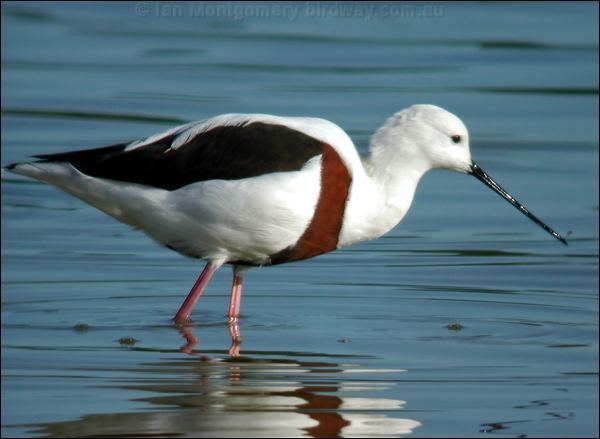 | ||
Genus CladorhynchusG.R. Gray, 1840 Scientific name Cladorhynchus leucocephalus Similar Lesser stick‑nest rat, Euastacus, Red‑necked avocet, Red‑capped plover, Red‑kneed dotterel | ||
Banded stilts along the way
The banded stilt (Cladorhynchus leucocephalus) is a nomadic stilt endemic to Australia. It belongs to the monotypic genus Cladorhynchus. It gets its name from the red-brown breast band found on breeding adults, but this is mottled or entirely absent in non-breeding adults and juveniles. Its remaining plumage is pied and the eyes are dark brown. They breed whenever the water conditions are suitable for brine shrimp to flourish and lay 3–4 white, brown or black eggs on a scrape. The majority of observed breeding events have occurred at inland salt lakes in South Australia and Western Australia immediately following freshwater inflows. An exception to this exists where some breeding was attempted at The Coorong during a time in which salinity in the Lower Lakes was significantly elevated due to reduced environmental flows down the Murray River.
Contents
- Banded stilts along the way
- Science screen report the banded stilt volume 39 issue 3
- Taxonomy
- Description
- Distribution and habitat
- Status and conservation
- Movements
- Breeding
- References
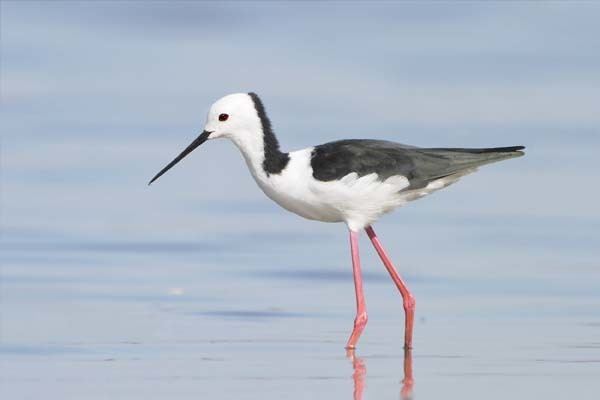
Science screen report the banded stilt volume 39 issue 3
Taxonomy
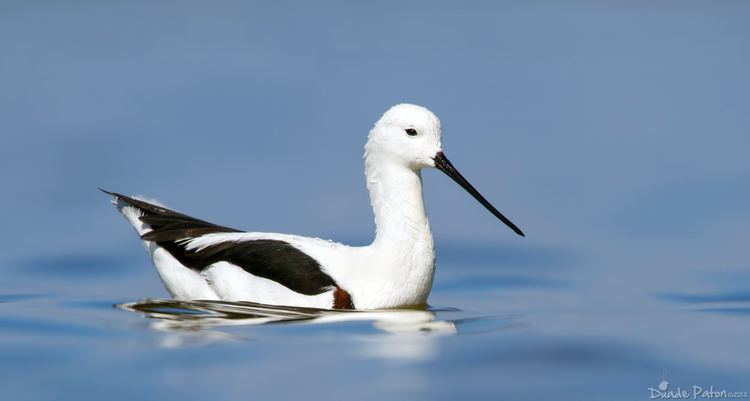
French ornithologist Louis Jean Pierre Vieillot described the banded stilt in 1816 as Recurvirostra leucocephala, "L'avocette a tete blanche", though the type locality has been listed as either Victoria or Rottnest Island in Western Australia. The species name is derived from the Ancient Greek words leukos "white", and kephale "head". Georges Cuvier described it as Recurvirostra orientalis the same year. Belgian ornithologist Bernard du Bus de Gisignies described it as a new genus and species, Leptorhynchus pectoralis, to the Royal Academy of Belgium in 1835.
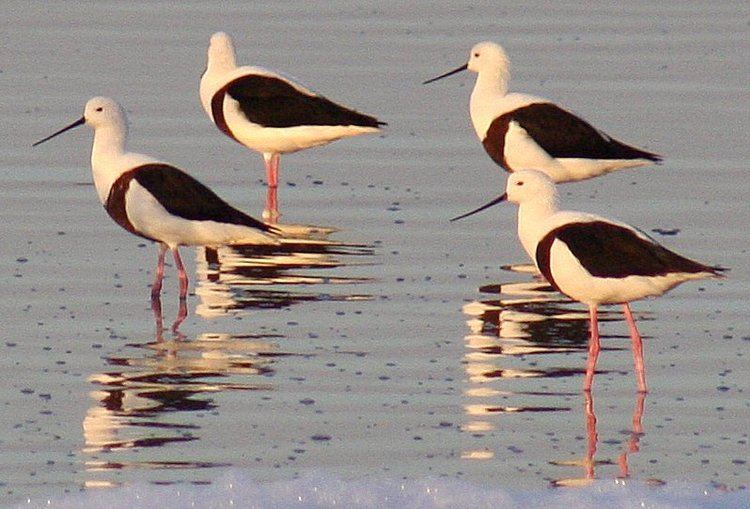
George Robert Gray placed the banded stilt in its own genus Cladorhynchus in 1840, noting that the name Leptorhynchus had been previously used. The genus name is from the Ancient Greek klados "twig" and rhynchos "bill". Likewise, German naturalist Johannes Gistel proposed the name Timeta for to replace Leptorhynchus in 1848. John Gould had described it as Himantopus palmatus in 1837, but recorded it as Cladorhynchus pectoralis in his 1865 work Handbook to the Birds of Australia. Gould also wrote that its distribution was unclear after it was first recorded at Rottnest Island though not elsewhere in Western Australia, and later in South Australia, until large numbers were seen by the explorer Charles Sturt at Lepson's Lake north of Cooper Creek in what is now western Queensland. Ludwig Reichenbach placed in a new genus, naming it Xiphidiorhynchus pectoralis in 1845. Australian ornithologist Fred Lawson gave it the name Cladorhynchus australis in 1904. Gregory Mathews in his 1913 List of the Birds of Australia synonymised all subsequent genus and species names, using Cladorhynchus australis. He listed his subspecies rottnesti from 1913, though this has not been recognised since. Both Joseph G. Strauch in a 1978 study and Philip C. Chu in a 1995 re-analysis of bone and muscle characters found that the banded stilt was sister to the avocets, with the stilts of the genus Himantopus an earlier offshoot. A 2004 study combining genetics and morphology reinforced its position as sister to the avocet lineage.
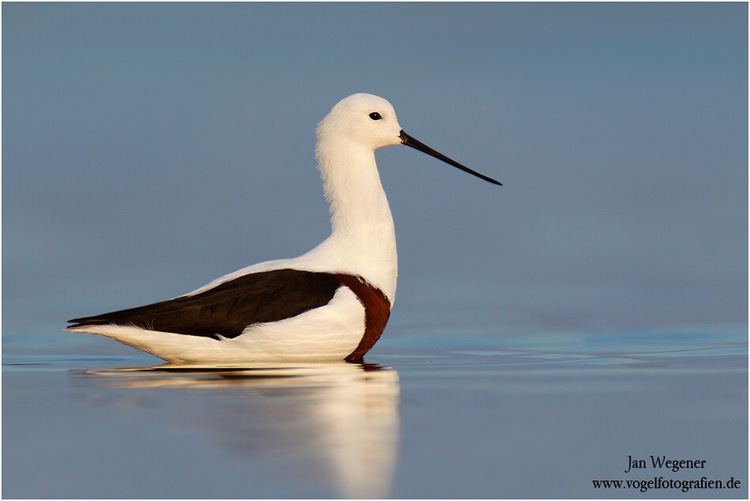
As well as banded stilt, the species has also been called locally Rottnest snipe, or bishop snipe. John Latham gave it the name oriental avocet in 1824, after Cuvier's description.
Description
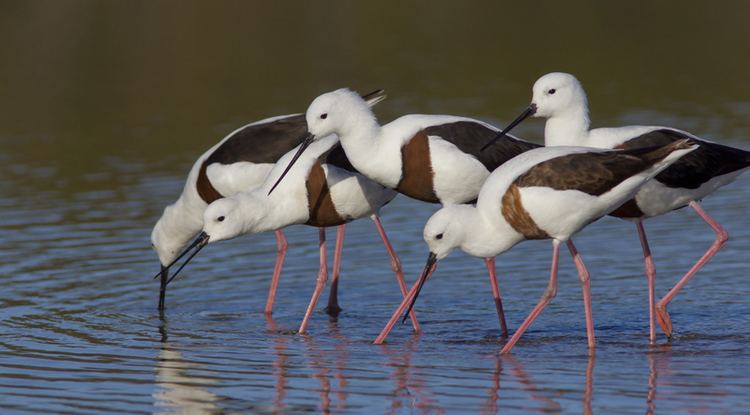
The banded stilt is 45–53 cm (18–21 in) long and weighs 220–260 g (7.8–9.2 oz), with a wingspan of 55–68 cm (22–27 in). Adults in breeding plumage are predominantly white with black wings and a broad well-demarcated u-shaped chestnut band across the breast. The central part of the upper tail is tinted a pale grey-brown. The long and slender bill is black, and twice as long as the head. The irises are dark brown and the legs and feet are a dark red-pink. The wings are long and slim and have eleven primary flight feathers, with the tenth being the longest. In flight, the wings are mostly black when seen from above but have a white trailing edge from the tips of the inner primaries. From underneath, the wings are predominantly white with dark tips. White feathers on the head and neck have pale grey bases, which are normally hidden. Non-breeding plumage is similar but the chest band is less distinct and often diluted to an ashy brown or mottled with white. The legs are a paler or orange-pink. There is no difference in plumage between the sexes, nor has any geographic variation been recorded.
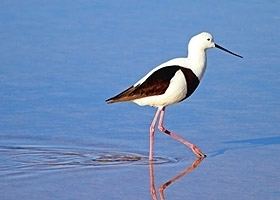
Juvenile birds resemble adults but lack the breast band and have greyish lores and forehead. The black on their wings is often duller. Adult plumage is attained in the second year. Their legs and feet are grey, becoming more blotched with pink until adulthood.
A distinctive bird, the banded stilt is hard to confuse with any other species; the related pied stilt lacks the breast band, and the red-necked avocet has a chestnut head and neck.
Baby banded stilts are covered in white down.
Distribution and habitat
The banded stilt is nomadic and generally found in southern Australia. In Western Australia, it is found predominantly in the southwestern corner, though can be as far north as the saltworks in Port Hedland. In 1933 a large colony had been recorded at Lake Grace, but had succumbed to attack by (presumably) foxes. The banded stilt has been recorded in southeastern South Australia, as well as the drainage of the Lake Eyre system, and in Victoria west of Port Phillip and the Wimmera. In New South Wales, it is most commonly found in the Riverina and western parts of the state, and has reached southern Queensland and the Northern Territory, where it has been found at the sewage ponds at Alice Springs and Erldunda. It has been recorded as a vagrant to Tasmania, with significant numbers recorded in 1981.
The preferred habitats are large, shallow saline or hypersaline lakes, either inland or near the coast, including ephemeral salt lakes, salt works, lagoons, salt- or claypans and intertidal flats. The species is occasionally found in brackish or fresh water, including farm dams and sewage ponds.
Status and conservation
The banded stilt was rated in 2012 as Least Concern on the IUCN Red List of Endangered species on the basis of its large range (greater than 20,000 km2) and fluctuating rather than declining population. However, it is listed as Vulnerable under the South Australian National Parks & Wildlife Act 1972. The listing was made after breeding attempts observed at Lake Eyre revealed heavy predation from silver gulls. DEWNR has developed a strategy for managing silver gull predation at chosen banded stilt breeding sites by applying site-specific culling measures. Breeding events observed at ephemeral lakes in Western Australia have proven to be more successful without the need for intervention due to their remoteness.
Movements
For the first time ecologists have tracked the movements of the highly nomadic banded stilt, a large desert bird that travels vast distances across the country to breed in desert salt lakes.
Deakin University researcher Reece Pedler said attaching tracking devices to 21 birds had unveiled amazing insights into the species' highly unpredictable mating behaviour, which relied on rare and short-lived flooding events. Since the first banded stilt breeding colony was discovered in 1930 there have been approximately only 35 breeding colonies recorded.
Data from the solar-powered tracking devices showed the birds moved much faster and further than most other waterbirds, with one animal journeying more than 2200 kilometres in two and a half days from Lake Eyre to an ephemeral lake. Another bird flew 1500 kilometres in six days.
While ecologists are yet to understand how the birds sense rain has fallen thousands of kilometres away, they may be responding to changes in barometric pressure, the sound of distant thunder or the smell of rain carried on long-range winds.
As part the study Mr Pedler had the unenviable task of trapping the difficult-to-catch birds to fit their satellite-tracking devices.
"We had to experiment with different methods of catching them. In the end I innovated with this hand-held net launcher and I'd creep up to the birds on a boogie board and fire a net over them at close range," he said.
Breeding
Breeding sites are generally on low islands, of 1–1.5 m (3–5 ft) elevation, or spits on or alongside large lakes, generally with sparse or no vegetation. Most sites are in Western Australia.
